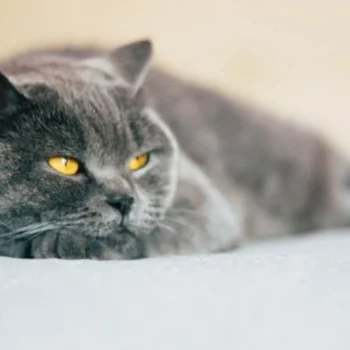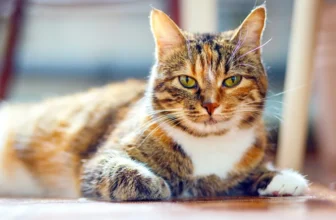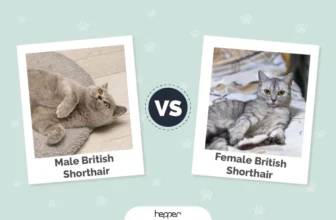Introduction
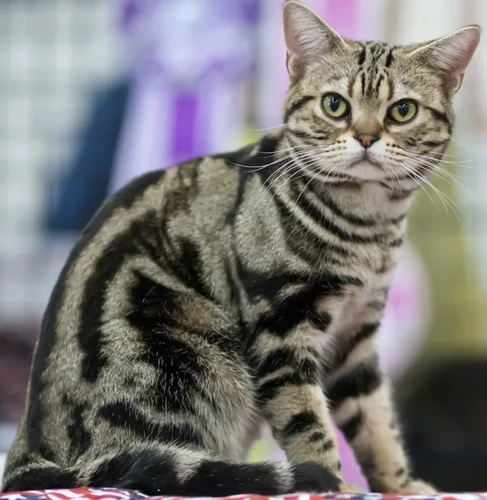
Cats are often seen as independent and self-sufficient creatures, but the truth is that they can experience stress just like humans. American Shorthairs, in particular, are known for their playful and outgoing personalities, but they can also be prone to stress and anxiety. If you’re a cat owner looking to provide a calming environment for your furry friend, read on for practical tips and techniques to ease your American Shorthair’s stress levels.
Understanding Your Cat’s Body Language
Understanding your American Shorthair’s body language is crucial to helping manage their stress levels. Your cat will communicate their emotions through their body posture, tail position, ear position, and vocalizations. Here are some common body language cues to look out for:
- Tail position: When a cat’s tail is held high and positioned upright, they are typically feeling confident and happy. However, if their tail is tucked between their legs, they may be feeling scared or anxious.
- Ear position: Pay attention to how your cat is holding their ears. If their ears are upright and perked forward, they are likely alert and curious. However, if their ears are flat against their head, they may be feeling fearful or stressed.
- Body posture: A relaxed and content cat will have a loose and open body posture. But if they are feeling aggressive or defensive, their body will be tense, and they may arch their back or puff up their fur to appear bigger.
- Vocalizations: Your cat may express themselves through meowing or purring. When they’re happy and content, they’ll purr softly. Still, if they’re anxious or agitated, their meows may become more frequent and high-pitched.
Understanding your American Shorthair’s body language can help prevent miscommunication and minimize the likelihood of aggressive or territorial behavior. It’s especially important to pay attention to their body language when introducing them to new pets or environments. If you want to learn more about American Shorthair body language, you can check out this article.
How Stress Affects Your Cat’s Health
Stress can have a profound effect on your American Shorthair’s health and well-being. Cats are known to be sensitive animals, and any changes in their daily routines or environment can trigger stress-related behaviors. Here are some ways stress can impact your cat’s health:
- Decreased Appetite: Stress can cause a decrease in appetite and lead to weight loss.
- Increased Aggression: When feeling stressed, your cat may become aggressive towards other pets or even humans, potentially causing harm. If you notice any aggressive or violent behavior from your cat, it’s important to address it immediately to prevent any injuries. You can refer to our article on aggressive behavior in American Shorthairs for more information.
- Urinary Issues: Stress can lead to urinary issues such as frequent urination, inappropriate urination, or blockage in males. This can lead to health complications, and immediate veterinary attention is necessary.
- Depression: Your cat may become withdrawn or depressed from stress, leading to a decrease in activity and a lack of interest in play or interaction.
- Behavioral Changes: Stress can also cause changes in your cat’s behavior, causing them to hide, become more vocal, or develop territorial behavior. To learn more about territorial behavior and how to address it, refer to our article on territorial behavior in American Shorthairs.
It’s essential to recognize these warning signs and take immediate steps to reduce the sources of stress for your American Shorthair. By addressing stress-related issues, you can promote a happier and healthier lifestyle for your feline companion. In the next section, we’ll discuss how to create a calm environment for your American Shorthair.
Creating a Calm Environment
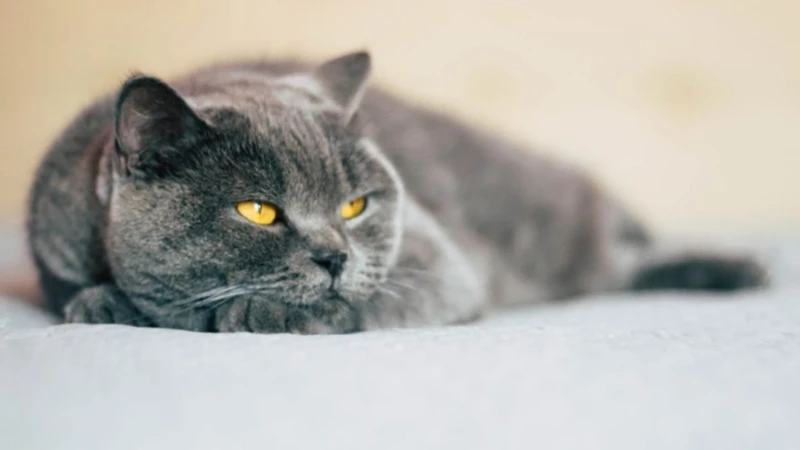
Creating a peaceful home environment is essential for managing the stress of your American Shorthair. A calm environment can help your feline friend feel safe, reduce anxiety, and prevent health issues caused by stress. To create a comfortable and stress-free living space for your pet, consider implementing the following tips.
Provide a Safe Haven
Creating a safe haven for your American Shorthair is an essential part of managing their stress levels. Having a designated space where they feel secure can go a long way in making them feel calm and relaxed. Here are some ways you can provide a safe haven for your feline friend:
- Provide a cozy bed: Set up a cozy bed in a quiet corner of your home where your American Shorthair can retreat whenever they feel overwhelmed. Make sure the bed is comfortable and warm, and consider using soft blankets or towels to make it even cozier.
- Create hiding spots: American Shorthairs often like to hide when they feel stressed, so providing hiding spots can be beneficial. This could be anything from a cardboard box to a cat condo. Consider placing them in various locations around your home, especially in areas where your cat spends the most time.
- Use calming scents: Certain scents, such as lavender, chamomile, and valerian root, have calming properties and can help reduce stress in American Shorthairs. Consider using a plug-in diffuser or a spray to add these scents to your cat’s safe haven.
- Minimize noise: Loud noises can be especially stressful for American Shorthairs. Consider using soundproof curtains or placing a white noise machine in their safe haven to block out unwanted noise.
- Provide climbing opportunities: American Shorthairs love to climb, and providing them with safe climbing opportunities can make them feel more secure. Investing in a cat tree or wall-mounted shelves can provide your cat with a high perch where they can observe their environment and feel safe.
By providing a safe haven for your American Shorthair, you can help them feel more secure and calm in their environment. If you want to learn more about making sure your American Shorthair is safe while climbing, check out our article about climbing safety.
Designate Play Areas
Creating designated play areas is an important aspect of managing an American Shorthair’s stress and promoting mental and physical well-being. Playing is an essential part of your cat’s daily routine and should be encouraged in a safe, low-stress environment. Here are some tips on creating play areas for your furry friend.
- Choose a quiet area: Cats prefer to play in a quiet area where they can concentrate fully. Select a spot in your house where your cat will not be disturbed by loud noises and where they can feel comfortable.
- Include toys: Cats can get bored easily with their toys, so make sure you have a variety of toys to rotate in and out of playtime. Interactive toys like feather wands, balls, and puzzle toys are especially useful for stimulating your cat’s mind.
- Consider different levels: Cats love height and they feel safe and secure up high. Consider adding cat trees, shelving, and scratching posts to create vertical space where your cat can climb, perch and look down on their kingdom.
- Keep it clean and safe: Your cat’s play area should be clean and free from hazards. Be sure to remove items that could be swallowed or cause harm, such as string, rubber bands or plastic bags.
- Regularly schedule playtime: Cats are creatures of habit, so it’s important to schedule regular playtime sessions each day. Spend at least 15-20 minutes engaging with your cat in their designated play area.
Creating designated play areas for your American Shorthair will allow them to satisfy their natural curiosity and provide an outlet for their energy, leading to a happier and healthier feline. It can provide an opportunity for bonding between you and your cat. Encourage positive behavior during playtime by offering treats and praise. You can learn more about positive reinforcement for American Shorthairs by clicking here.
Provide Sensory Stimulation
Cats love exploring their surroundings, and sensory stimulation is essential for their overall well-being. Providing your American Shorthair cat with opportunities for sensory stimulation will help keep them entertained and mentally stimulated, reducing their stress levels. Here are some tips to help stimulate their senses:
| Sense | Technique |
|---|---|
| Sight | Place a bird feeder outside a window or place a cat tree by a window with a view to keep your cat entertained by birds and other wildlife. |
| Hearing | Play soothing music or sounds of nature such as bird songs or falling rain. Kittens tend to enjoy playful and upbeat music or bird sounds, while older cats may prefer calming sounds. |
| Smell | Use catnip and other cat-friendly scents around the house to stimulate your cat’s sense of smell. You can also use herbs such as chamomile and lavender. |
| Taste | Try offering your cat different flavors and textures of food. You can also provide treats that require some effort to access, such as treat balls or puzzle feeders to keep your cat’s mind sharp and entertained. |
| Touch | Provide a variety of textures for your cat to experience. This includes different types of beds, blankets and toys with various textures such as plush, rough, and smooth. Male and female American Shorthairs may have different preferences when it comes to texture, so be sure to experiment. |
By providing sensory stimulation, you can help your American Shorthair maintain a healthy mind and body. It is important to note that every cat is different, and you may have to try different techniques to see what works best for your cat. Thanks to sensory stimulation, your cat can maintain their mental and physical health.
Minimize Environmental Stressors
Just like humans, cats can experience stress from environmental factors. As a responsible cat owner, it is important to do everything within your power to minimize stressors and create a calm environment for your American Shorthair. Here are some tips:
| Noise | Avoid loud noises such as vacuum cleaners, blenders, or loud music. If your cat is noise-sensitive, consider getting earplugs for them. |
| Lighting | Provide a well-lit but not overly bright space for your cat. Too much or too little light can cause stress and disrupt their natural sleep cycle. |
| Temperature | Keep your home at a comfortable temperature for your American Shorthair. Extreme cold or heat can cause stress and discomfort for them. |
| Cleanliness | Ensure that your cat’s litter box is cleaned regularly, as a dirty litter box can cause stress and lead to health problems like urinary tract infections. Check out our article on American Shorthair litter preferences for more information. |
| Separation Anxiety | Try to minimize the amount of time your cat spends alone. If you have to leave your cat for an extended period of time, provide a safe space for them to rest in, such as a cozy bed or hiding spot. Check out our article on introducing your American Shorthair to new pets for more tips on separation anxiety. |
By taking steps to minimize environmental stressors, you can help create a serene living space for your American Shorthair. Keep in mind that cats are sensitive creatures who pick up on subtle changes in their environment, so it is important to be mindful of their needs.
Implement Relaxation Techniques
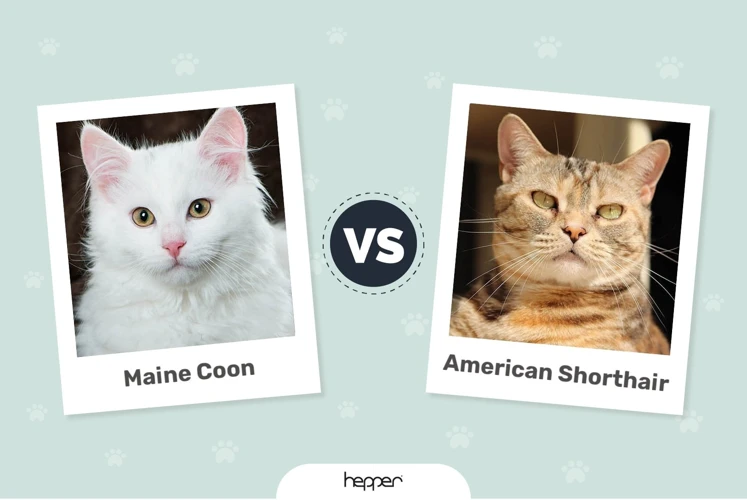
Now that you understand the causes and effects of stress on your American Shorthair, it’s time to explore some relaxation techniques. Life can be stressful for cats too, and using these techniques can help reduce stress and promote a calm environment for your feline friend. From setting a routine to providing natural remedies, there are several effective ways to help your American Shorthair relax and live a happy and healthy life. Let’s take a closer look at some of these techniques.
Set a Routine
Creating a consistent routine can help reduce stress in American Shorthairs, providing a sense of structure and predictability. Scheduling specific times for feeding, playtime, and sleep can also improve behavior and overall well-being.
Feeding Time: Establishing a regular feeding schedule can help regulate your cat’s digestion and reduce anxiety around mealtime. Consider feeding your American Shorthair small, frequent meals throughout the day instead of one or two large meals. A timed feeder can also be a great tool for providing regular nourishment and structure.
Playtime: Devoting specific times for play can help your cat burn off excess energy and reduce stress. Provide interactive toys, such as feather wands or laser pointers, to stimulate your cat’s hunting instincts and provide mental stimulation.
Sleep: Cats are known for their love of napping, but establishing a designated sleep space and time can promote deeper and more restful sleep. Consider providing a cozy cat bed or designated sleeping area with a comfortable blanket or cushion. Creating a nighttime routine, such as providing a calming scent or dimming the lights, can also help your American Shorthair relax and settle in for the night.
Training: Incorporating training sessions into your cat’s routine can provide mental stimulation and help improve behavior. Utilize positive reinforcement techniques, such as treats or praise, to encourage desired behaviors and discourage unwanted behaviors.
By establishing a routine for your American Shorthair, you can create a calming and predictable environment that can reduce stress and promote overall well-being.
Treats as Positive Reinforcement
Positive reinforcement is often used in animal training to encourage desired behavior. Treats can be a valuable tool in managing your American Shorthair’s stress by providing positive reinforcement. However, it is important to make sure that treats are given in moderation and not used as the sole method of managing stress.
Here are some tips for using treats as positive reinforcement:
- Choose healthy treats: Opt for treats that are low in calories and do not contain any harmful ingredients. Look for treats that are specifically designed for cats and check with your veterinarian if you are unsure about the nutritional value.
- Use treats consistently: Be consistent with when you give treats to reinforce good behavior. This helps your cat understand what behavior is desired and what will be rewarded.
- Praise verbal commands: In addition to offering treats, praise your cat’s behavior with verbal commands. This helps reinforce understanding without giving excess treats.
- Avoid punishing bad behavior: Instead of punishing bad behavior, focus on reinforcing good behavior. This positive approach can lead to more consistent, long-term results in managing stress.
- Maintain a routine: Once you begin using treats as positive reinforcement, maintain a schedule and routine. This consistency will help reduce stress and anxiety in your cat.
- Use treats in combination with other techniques: Keep in mind that using treats alone is not the only way to manage your cat’s stress. Use treats in combination with other techniques, such as creating a calm environment, to provide a comprehensive approach to managing your cat’s stress.
By following these tips, you can use treats as a valuable tool in managing your American Shorthair’s stress and promote positive behavior. Remember to always use treats in moderation and consult your veterinarian for additional advice.
Massage and Grooming Practices
Cats are known to be natural groomers, but sometimes they can benefit from a little extra help. Regular grooming practices are not only important for maintaining a healthy coat and preventing hairballs, but they can also provide your American Shorthair with much-needed relaxation.
To start, invest in a good quality cat brush. Using soft, gentle strokes, brush your cat’s fur in the direction of hair growth. Be mindful of any sensitive areas, such as the belly or tail, and avoid applying too much pressure. Brushing helps to remove loose fur and dirt, and also stimulates blood flow to the skin. This can have a calming effect on your cat and help them feel more relaxed.
In addition to regular brushing, massage can also be an effective relaxation technique for your American Shorthair. Start by gently stroking your cat’s head and neck, and then move on to their back and sides. Use slow, circular motions and apply gentle pressure. Pay attention to your cat’s body language and adjust the intensity and duration of the massage accordingly. Some cats may prefer a shorter session, while others may enjoy a longer massage.
One area that is often overlooked when it comes to grooming is the paws. Cats use their paws to explore the world around them, and it’s important to keep them in good condition. Regularly trimming your cat’s nails can prevent them from becoming overgrown and causing discomfort. Use specialized cat nail clippers and trim only the tip of the nail, being careful not to cut into the quick (the pink part of the nail that contains blood vessels and nerves).
Incorporating regular grooming and massage practices into your American Shorthair’s routine can be a great way to promote relaxation and reduce stress. Remember to be patient and gentle, and to pay attention to your cat’s body language to ensure they are comfortable and happy.
Human Interaction
Cats are social animals and require human interaction to establish a strong bond and relieve stress. Some ways to interact with your American Shorthair include:
- Playtime – engage in interactive play with toys such as a wand or laser pointer. This can help release pent-up energy and reduce stress levels.
- Cuddle time – petting and cuddling your cat can release endorphins, promoting a sense of well-being and relaxation.
- Talk to your cat – cats respond to tone of voice, so speaking in a calm and reassuring tone can help your cat feel at ease.
- Teach tricks – teaching your cat tricks such as sit, stay, or come can help stimulate their mind and relieve boredom.
- Provide visual stimulation – setting up a bird feeder outside a window or leaving a TV on with nature shows can provide entertainment for your cat.
- Respect their boundaries – while companionship is important, it’s important to respect when your cat wants alone time. Avoid forcing interaction and let your cat come to you.
Remember to always observe your cat’s body language during interaction and adjust accordingly. Pay attention to signs of stress such as dilated pupils, flattened ears, or a twitching tail. With proper human interaction, your American Shorthair can thrive and live a stress-free life.
Natural Remedies and Medications
One way to manage your American Shorthair’s stress is by using natural remedies and medications. Here are some natural remedies and medications that can help promote relaxation and reduce stress in your furry friend:
- Valerian root: Valerian root is a natural sedative that can help calm and relax your cat. You can give your cat valerian root in the form of a supplement or sprinkle it on their food. It’s important to note that valerian root can cause drowsiness, so it’s best to give it to your cat before bedtime or when you know they will have a quiet day.
- Chamomile: Chamomile is a herb that has a calming effect on the body and can help reduce anxiety and stress in your cat. You can give your cat chamomile in the form of a supplement or use it as a tea rinse for their coat. It’s important to note that some cats may be allergic to chamomile, so it’s best to start with small doses and monitor your cat’s reaction.
- Essential oils: Certain essential oils, such as lavender and frankincense, can help promote relaxation and reduce stress in your cat. You can diffuse essential oils in your cat’s living spaces or use them in a diluted form for massage or grooming. It’s important to note that some essential oils can be toxic to cats, so it’s best to do your research and consult with a veterinarian before using them.
- CBD oil: CBD oil is derived from hemp and can help promote relaxation and reduce anxiety in your cat. It’s best to choose a high-quality CBD oil that has been specifically formulated for pets. The dosage depends on your cat’s weight and the severity of their stress and anxiety.
- Prescription medications: If your cat’s stress and anxiety are severe, prescription medications may be necessary to manage their symptoms. Your veterinarian can prescribe medications such as fluoxetine or amitriptyline, which can help reduce anxiety and promote relaxation in your cat. It’s important to follow your veterinarian’s instructions carefully and monitor your cat for any side effects.
Remember, natural remedies and medications should be used in conjunction with other stress-reducing techniques and in consultation with a veterinarian.
Promoting Healthy and Happy Lifestyles
As a cat owner, promoting healthy and happy lifestyles for your American Shorthair should always be a top priority. This involves more than just managing your cat’s stress levels; it also means making sure they are receiving proper nutrition and exercise, and providing a comfortable sleep environment. By incorporating a few simple changes into your cat’s routine, you can help them live a long and fulfilling life. Let’s explore some ways to promote health and happiness for your feline companion.
Dietary Changes
A healthy diet is essential for maintaining a happy and stress-free life for your American Shorthair. Proper nutrition can help improve your cat’s mood, increase energy levels, and create a healthy digestive system.
Consult with a veterinarian: Before making any dietary changes to your cat’s lifestyle, it is essential to consult with a veterinarian. They will recommend the appropriate diet required for your cat’s age, weight, and health conditions.
High-quality cat food: High-quality cat food should contain all the essential nutrients that your cat needs. Look for cat foods that contain ingredients such as animal proteins, minerals, and vitamins. Avoid cat food that contains fillers, grains or too many carbohydrates.
Raw cat food diet: A raw cat food diet is highly recommended for American Shorthairs. The diet should consist of raw meat, bones, organs, and vegetables. Raw diets for cats have been shown to decrease the likelihood of chronic diseases such as obesity, allergies and promotes a healthy coat.
Hydration: Provide your cat with freshwater daily. Keep a water bowl near their eating and sleeping area to encourage them to drink more water. Wet cat food can also help with hydration. Feeding your cat dry food exclusively can cause dehydration and increase their stress levels.
Meal frequency: Adult cats should be fed 2-3 small meals a day rather than 1-2 large meals. This will help regulate their metabolism and maintain their blood sugar levels. Feeding smaller meals will also help your cat maintain a healthy weight.
Consider investing in a slow feeder bowl to control mealtime. Slow feeder bowls can help prevent your cat from eating too fast and overeating.
| Food to avoid: | Benefits: |
|---|---|
| Artificial Additives: | Avoid artificial additives that can increase stress levels in cats |
| Caffeine: | Caffeine stimulates the nervous system and can cause anxiety | Alcohol& Chocolate: | Both contain compounds that can be toxic to cats and stress their digestive systems. |
Incorporating these dietary changes into your American Shorthair’s lifestyle can help them live a happy, healthy, and stress-free life. Remember to consult with a veterinarian before making any significant changes and always ensure your cat has access to fresh water.
Activity and Exercise
Regular physical activity and exercise are essential for your American Shorthair’s mental and physical well-being, and can help alleviate stress. A great way to ensure that your cat gets sufficient exercise is by playing with them regularly. Here are some activities and exercise options that you can implement:
| Activity/Exercise | Description |
|---|---|
| Interactive Toys | Interactive toys like laser pointers or wand teasers can provide mental and physical stimulation for your cat as they chase after them. It also provides a bonding experience for you and your cat. |
| Cat Trees | Cats love to climb, scratch, and play, and cat trees provide ample opportunities for all three. They also provide a great lookout point for your cat, which can reduce stress. |
| Scratching Posts | Scratching is a natural behavior for cats, but it can also help alleviate stress and anxiety. Providing your cat with a scratching post can give them an outlet for this behavior. |
| Treat Dispenser Toys | Treat dispenser toys can provide both physical and mental stimulation for your cat as they work to get the treats out of the toy. It can also help stimulate their natural hunting instincts. |
| Encourage Playtime | It’s important to set aside time each day to play with your American Shorthair. This can help reduce their stress levels and provide an opportunity for bonding between you and your cat. |
Remember, providing your cat with ample opportunities for exercise and play can help reduce stress and keep them healthy and happy.
Sleep Environment
Cats can be quite finicky about their sleep environments, so it’s important to create a relaxing and comfortable space for them to rest. Here are some tips to consider:
- Choose a cozy bed: Providing your American Shorthair with a comfortable bed is essential for a good night’s sleep. Make sure it is the right size for your cat and wash it regularly to keep it clean and fresh.
- Find the perfect location: Cats tend to prefer quiet and secluded areas to sleep. Find a spot in your home that provides peace, quiet, and privacy for your feline friend to rest undisturbed.
- Block out noise and light: Just like humans, cats can be sensitive to noise and light when trying to sleep. Consider using earplugs, a white noise machine or a heavy curtain to block out any distractions that may disturb your cat’s sleep.
- Regulate the temperature: Ensure that the room temperature is comfortable for your cat to sleep in. It’s important to make sure they are not too hot or too cold, which can affect the quality of their sleep.
- Make the bed cozy: Add soft blankets or a warm pad to your cat’s bed to make it extra cozy. This will help them feel more comfortable and relaxed, and promote a restful sleep.
By creating a comfortable sleep environment for your American Shorthair, you can help promote healthy sleep habits and reduce stress levels. Remember to observe your cat’s behavior and preferences, as every cat is unique and may have different needs when it comes to sleep.
Conclusion
After implementing the tips and techniques shared in this article, you should notice a significant positive change in your American Shorthair’s overall well-being. By creating a calm environment, implementing relaxation techniques, and promoting healthy lifestyles, you have taken important steps to manage your cat’s stress and ensure a happy life. Remember to always pay attention to their body language and behavior, and adjust your approach accordingly. With consistency and patience, you can create a lasting bond with your furry friend and provide a peaceful and loving home.
Final Thoughts
As a responsible cat owner, you must prioritize managing your American Shorthair’s stress. Remember that stress can lead to various health problems over time, so it is essential to address it right away. By creating a calm environment, implementing relaxation techniques, and promoting healthy lifestyles, you can help your furry friend live a happy and healthy life. Here are some final tips to keep in mind:
| Tip | Description |
|---|---|
| Monitor Your Cat’s Behavior | Always be observant of your cat’s actions and check for any signs of stress, such as excessive grooming or aggression. Address these concerns promptly. |
| Regular Vet Visits | Take your cat for regular checkups and discuss any concerns regarding your cat’s health and behavior with your veterinarian. |
| Be Patient | Managing your cat’s stress can take time and effort. Be patient and consistent in your efforts, and eventually, you will see a positive change in your cat’s behavior. |
| Celebrate Achievements | When your cat responds positively to your efforts, take time to celebrate their achievements. This positive reinforcement will encourage your cat to continue the good behavior. |
Remember that every cat is unique, and you may need to experiment with different techniques to find what works for your American Shorthair. The most important thing is to show patience, love, and care towards your furry friend. With your continued efforts, your cat will live a fulfilling life free from the harmful effects of stress.
Frequently Asked Questions
Can American Shorthair cats be prone to stress?
Yes, just like any other animal, American Shorthair cats can experience stress.
What are some signs that my American Shorthair cat is stressed?
Signs of stress in American Shorthair cats can include changes in appetite, excessive grooming, hiding, and aggressive behavior.
How can stress affect my American Shorthair cat’s health?
Stress can lead to a weakened immune system, digestive issues, and negatively impact their overall well-being.
What can I do to create a calm environment for my American Shorthair cat?
You can provide a safe space, designate play areas, and minimize environmental stressors in your home.
Are there any relaxation techniques that can help my American Shorthair cat?
Yes, setting a routine, using treats as positive reinforcement, massage and grooming practices, human interaction and natural remedies can all be helpful relaxation techniques.
Can dietary changes help reduce stress in American Shorthair cats?
Yes, feeding your American Shorthair cat a balanced and nutritious diet can help promote their overall health and reduce stress.
How important is exercise and activity for American Shorthair cats?
Physical activity and exercise is important for maintaining your American Shorthair cat’s physical and mental well-being, and can help reduce stress.
What kind of natural remedies can help reduce stress in American Shorthair cats?
Some natural remedies that can help reduce stress in American Shorthair cats include pheromone sprays, calming herbs and supplements, and diffusing essential oils.
Can medication be used to help reduce stress in American Shorthair cats?
Yes, in some cases, medication prescribed by a veterinarian can be used to help manage and reduce stress in American Shorthair cats.
Why is it important to manage stress in American Shorthair cats?
Managing stress in American Shorthair cats is important because it helps promote their overall health and well-being, as well as improves their quality of life.

